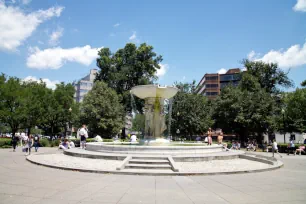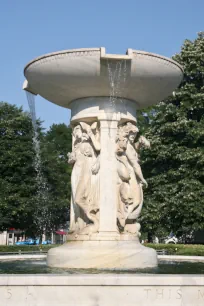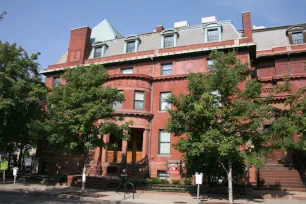Dupont Circle is a large traffic circle from which no less than ten streets radiate in all directions. At its center is a beautiful memorial fountain with allegorical sculptures.

The traffic circle is at the heart of a neighborhood full of magnificent mansions, definitively worth exploring for anyone with an interest in architecture.
Samuel Francis du Pont
Dupont Circle was originally named Pacific Circle and was laid out on the north-west edge of the city. In 1882, it was named after Samuel Francis du Pont, a naval admiral in the Civil War who became a hero after his capture of Port Royal, South Carolina. The admiral was relieved of his command in 1863 after a defeat at Charleston Harbor.
In 1884 a bronze statue of the admiral, created by the Irish-American sculptor Launt Thompson, was erected in the middle of the traffic circle to honor his services. On request of the family of the admiral, the statue was moved in 1920 to their estate in Wilmington, Delaware.

The Fountain
The du Pont family decided a more grand monument was needed to commemorate the admiral and financed the construction of a monumental fountain to replace the statue. They commissioned sculptor Daniel Chester French and architect Henry Bacon, who earlier had worked together on the Lincoln Statue of the Lincoln Memorial, with the creation of the fountain. It was unveiled on the traffic circle in 1921.
The fountain is adorned with three allegorical statues, about eight feet tall (2.5 meters), that are set against a column that supports a circular marble basin. One of the female statues represents the sea. She holds a ship model in her right arm. Another female figure, with a globe in her hand, represents the stars. The third figure is that of a young man who represents the wind. Between his feet sails a ship with billowing sails.
The Neighborhood
Dupont Circle is also the name given to the neighborhood around the traffic circle. Until the Civil War, this was a rural area with unpaved streets. After the end of the war the area started to develop rapidly, and it soon became one of the most fashionable places to live in the country. The wealthy built large, palatial mansions, and at the start of the twentieth century it rivaled New York’s Fifth Avenue as the place to live for the nouveau riche.

Many of the neighborhood’s wealthy residents were hit by the 1929 stock market crash and the subsequent Great Depression. They sold their properties, and many of these mansions were divided into smaller apartments and rented out to middle-class families.
The area declined until the 1970s, when young people started to discover the neighborhood and restored old houses. Art galleries, bars, restaurant and bookstores settled in the area. Starting in the 1980s, the Dupont Circle area begun to attract a more wealthy clientele, and it is now once again an upmarket address.
Meanwhile, many of the largest mansions that were once built by some of the country’s most wealthy individuals were occupied by embassies. In fact, there are so many embassies here that the north-west area of Dupont Circle, around Massachusetts Avenue, became known as ‘Embassy Row’.

